As Earth Day approaches, it’s the perfect opportunity for marketers to explore innovative ways to engage with eco-conscious customers. With a strong and growing interest in sustainable business practices worldwide, green audiences are becoming increasingly influential. In addition to being good for the planet, engaging these customers is great for any brand or organization striving to become more eco-friendly and socially responsible. By taking advantage of this timely event and using appropriate tools, you can create personalized campaigns that will both promote your brand and increase customer loyalty.
Eco-conscious audiences
In this blog post, we’ll cover three eco-conscious audiences to target this Earth Day:
- Solar energy
- GreenAwareTM
- Electric vehicles
Solar energy
Our first eco-conscious audience is Solar energy. Consumers in this audience show an inclination toward harnessing the power of the sun as a clean, renewable energy source. Our audience data can provide valuable insights into the Solar energy consumer base, including their age, education level, occupation, household income, and communication preferences. Let’s explore these metrics to better understand how to reach this group effectively.
Age and living situation
Consumers in our Solar energy audience are more likely to live in a home with two or more adults and are between the ages of 45-74.
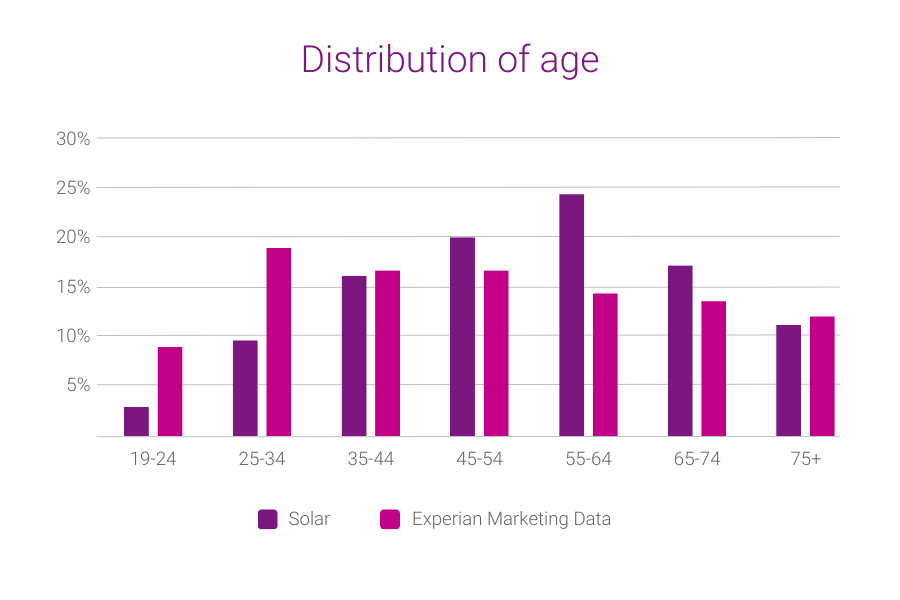
Education level and occupation
Consumers in our Solar energy audience are more likely to have graduated from college or graduate school and work in management-level occupations.
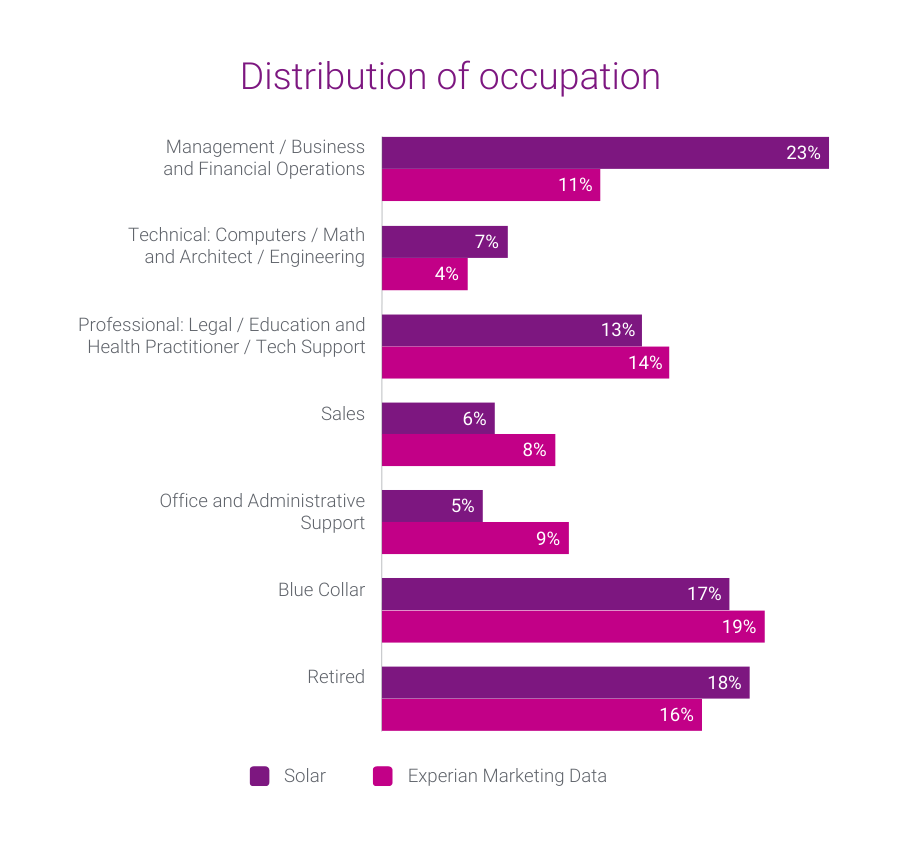
Household income
Consumers in our Solar energy audience have household incomes of more than $75,000 and their homes are valued at over $550,000.
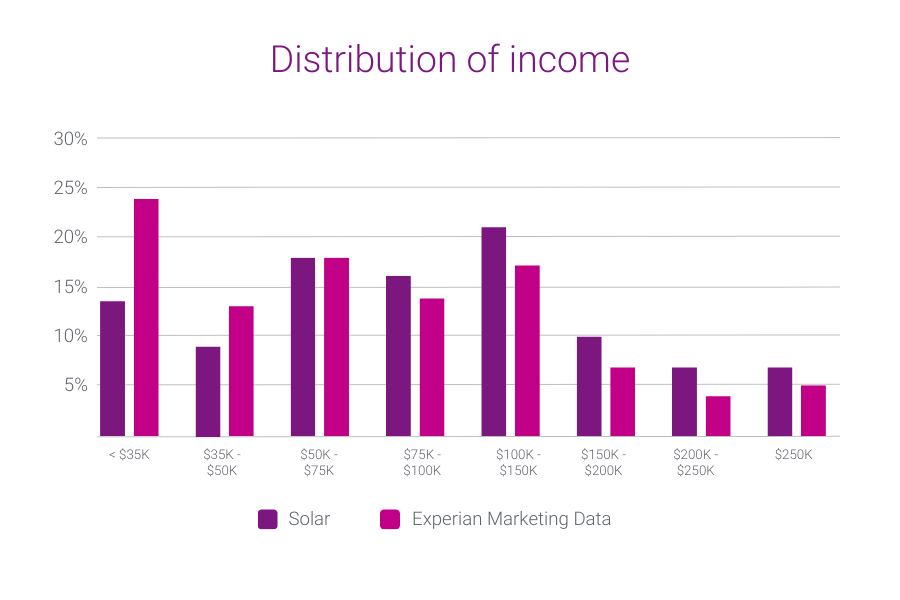
Preferred engagement channels
Consumers in our Solar energy audience are most receptive to ads served through digital channels like digital newspapers and email.
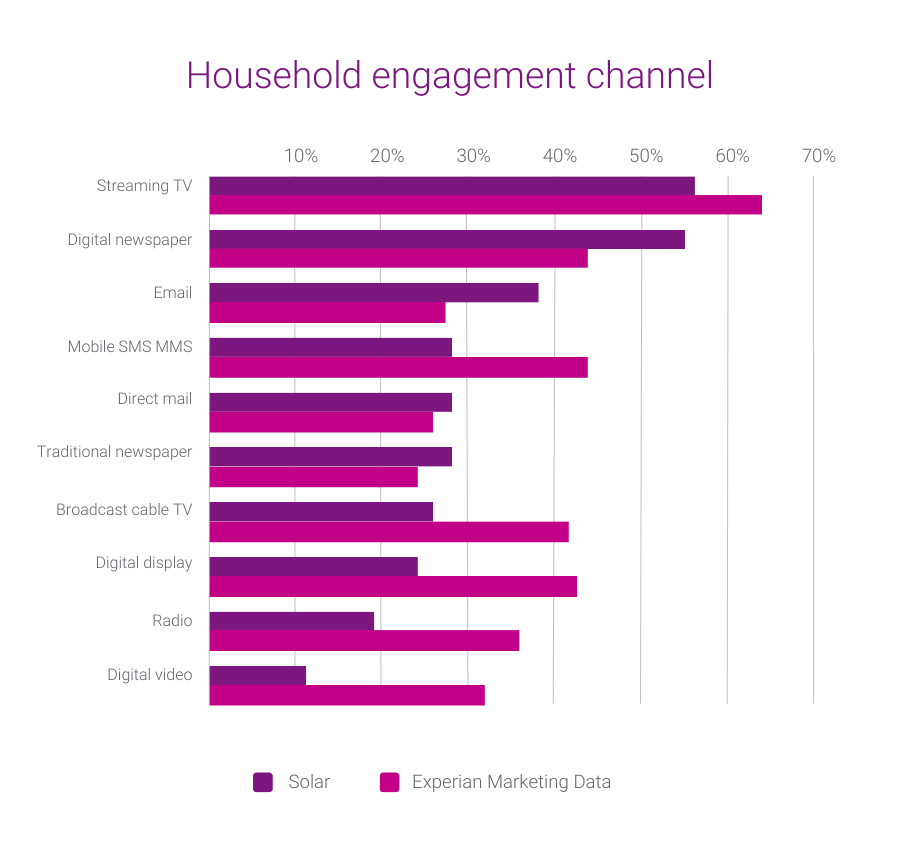
Solar energy audience pairings
Consumers in our Solar energy audience also belong to three of our Mosaic® USA groups:
- Power Elite
- Flourishing Families
- Booming with Confidence
Our consumer segmentation portal of 126 million households and 650 lifestyle and interest attributes empowers marketers like you to precisely target your ideal audience and communicate with them on a personal level. Mosaic’s data segments the U.S. into 19 overarching groups and 71 underlying types, giving you the insights needed to anticipate the behavior, attitudes, and preferences of your most profitable customers and communicate with them on their preferred channels, with messaging that resonates.
GreenAware
Our second eco-conscious audience is GreenAware.
GreenAware segments the 126 million U.S. households within Experian Marketing Data into four distinct groups. Each group differs in their attitudes and behaviors toward purchasing products that are environmentally safe and working with companies that are eco-conscious. We created these groups using an enhanced application of traditional statistical clustering techniques based on environmentally relevant measurements in Simmons’ National Consumer Study.
Based on the distinctive mindset of consumers toward the environment, you can learn how environmental concerns fit into their lives through four major consumer segments:
- Eco-Friendly Enthusiasts
- Sustainable Spectators
- Passive Greenies
- Eco Critics
Let’s dive deeper into each group to understand their unique perspective on the environment and how this impacts their attitudes and behaviors.
Eco-Friendly Enthusiasts
This eco-conscious segment prioritizes a green lifestyle and takes pride in avoiding products that harm the planet. With traditional and liberal values, they embrace optimism and prioritize family. With their children out of the house, they take the time for some well-deserved rejuvenation and are committed to a healthy lifestyle. Some members of this group are transitioning into retirement and welcoming a new chapter in their life.
- Mature adults and retirees
- College graduate or more
- Above average income
- May be married or single
- Typically own their homes
Sustainable Spectators
This segment aspires to be more sustainable, but they struggle with translating their green ideas into action. They have a soft spot for a cozy home. While their love for interior design and taking care of their own space is evident, they’re always looking for new experiences and opportunities to learn. Staying healthy and active is a top priority for this group, so it’s no surprise that they’re always looking for ways to stay fit and feel their best.
- Established and mid-life adults
- College graduate or more
- High income
- Typically married
- Likely to own their homes
Passive Greenies
This is the largest and one of the most youthful groups. Known for their love of exploration and self-discovery, they may not have fully embraced eco-conscious behaviors yet, but they are eager to stay current with the latest technology and trends. With their incredible ability to multitask, they’re always on-the-go, and constantly seek the next best thing.
- Mainly young adults and diverse
- Education ranges from high school through some college
- Below average income
- More likely to be single or divorced
- Typically rent
Eco Critics
This group is not likely to be eco-conscious and may have negative attitudes about the environment. They are confident, driven, and focused on their personal growth. They crave instant gratification, seeking out quick and easy solutions to their everyday decisions. They place a high value on entertainment, their social life, and carefully curate their image.
- Young and established adults
- Education ranges from high school through post-graduate studies
- High income
- Married or single
- Typically own their homes
Let’s take a look at how the GreenAware segments stack up against each other in terms of age, household income, education level, and media preference. How do they compare? Let’s find out.
Age
Consumers in the Eco-Friendly Enthusiasts segment are the oldest of the four GreenAware segments – about half of the consumers are 65 or older. Eco Critics are the youngest segment, with over half of consumers in this group between ages 25-44.
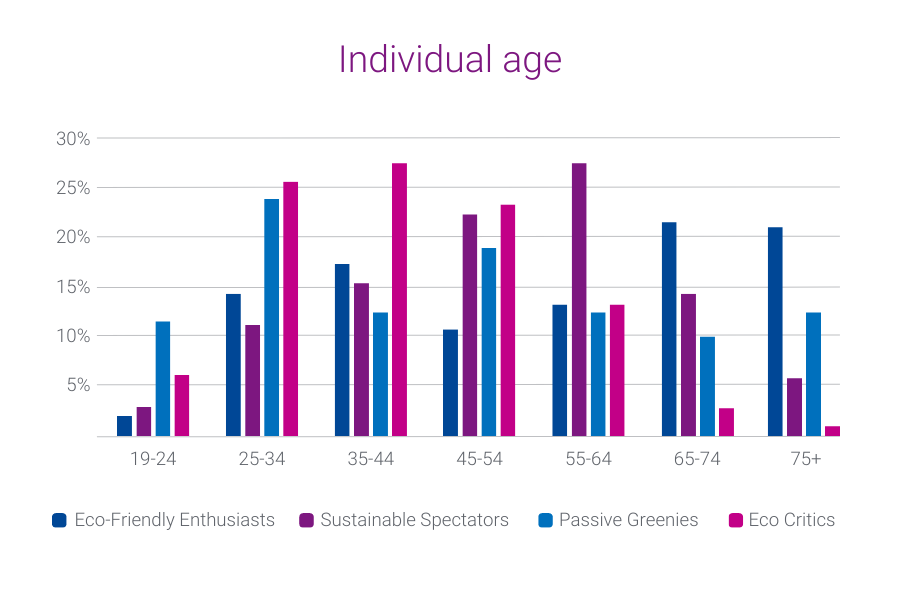
Household income
Sustainable Spectators and Eco Critics are the wealthiest GreenAware segments. The average household income of consumers in these segments is above $100,000. Passive Greenies have the lowest household income, with a majority below $50,000.
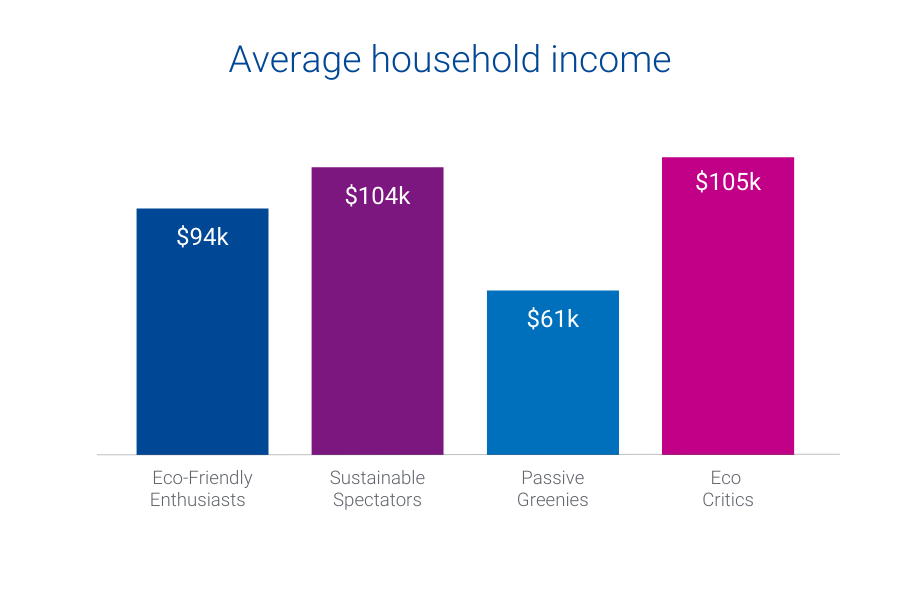
Education level and occupation
Passive Greenies are more likely to work Blue Collar jobs and have the lowest level of education. As the wealthiest segments, Sustainable Spectators and Eco Critics have the highest levels of college degrees and work in management, business, and financial operations. Eco-Friendly Enthusiasts are the most likely to be retired and out of the workforce.
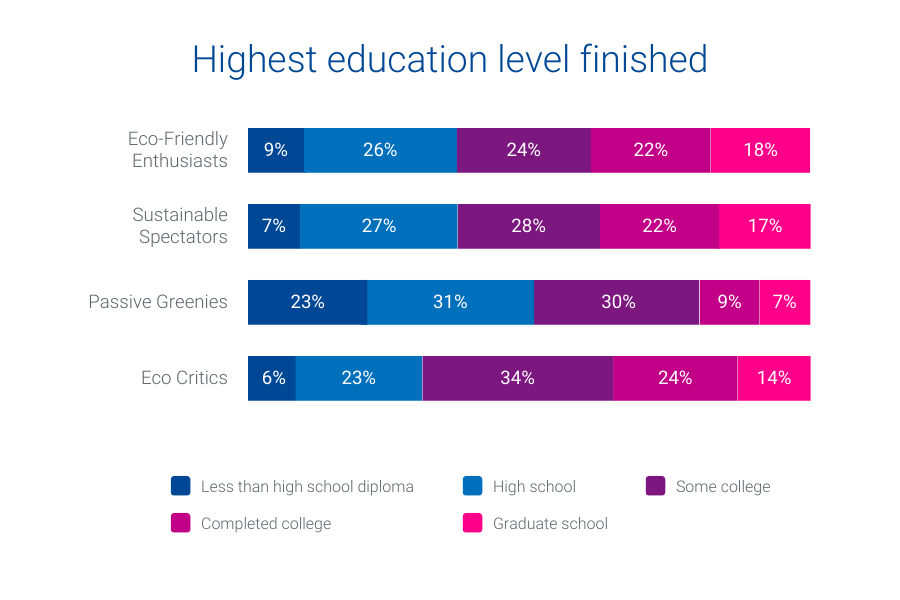
Preferred engagement channels
- Streaming TV is the preferred engagement channel for all GreenAware segments.
- Eco-Friendly Enthusiasts prefer digital channels like digital newspapers, mobile SMS, and email. They also engage with traditional channels like direct mail and newspaper.
- Passive Greenies have a high preference for digital display, mobile SMS, digital video, broadcast cable TV, and radio.
- Eco Critics have a high preference for digital channels like digital newspapers, mobile SMS, and digital display.
- Sustainable Spectators strongly prefer digital newspapers. They don’t show as strong of a preference for mobile SMS and digital display as Eco Critics and Passive Greenies.
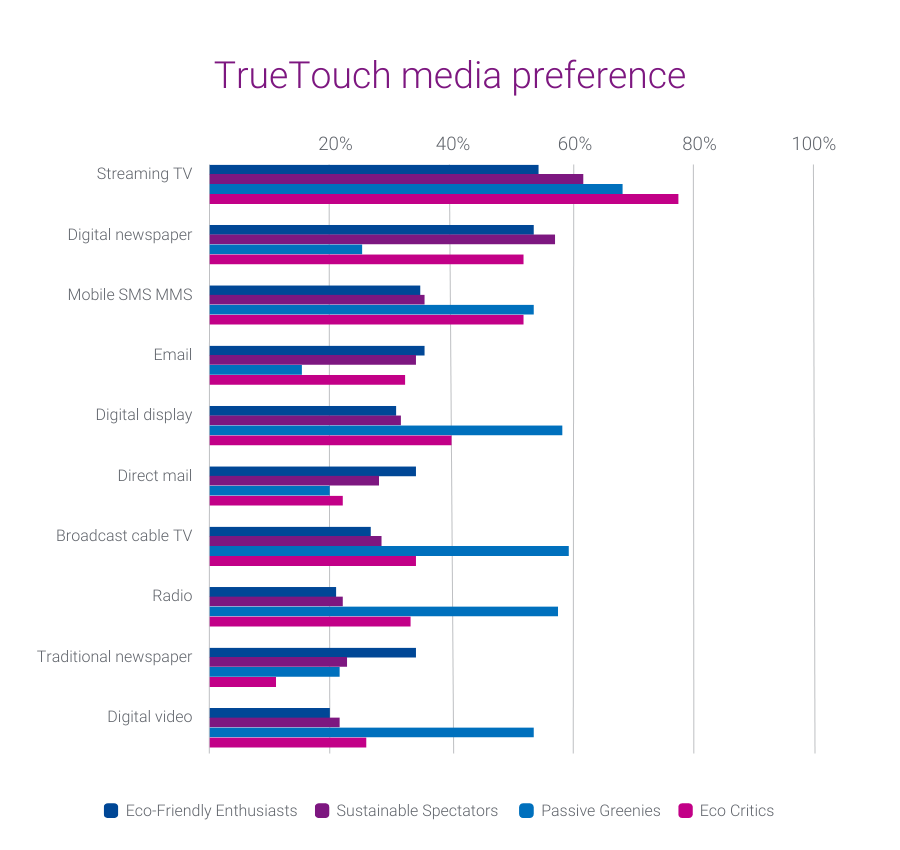
GreenAware audience pairings
Six of our Mosaic groups have at least one GreenAware segment with 10% or more of the population. For more precise targeting, below are suggested Mosaic audiences you can pair with each GreenAware segment:
| Eco-Friendly Enthusiasts | Sustainable Spectators | Passive Greenies | Eco Critics |
| Booming with Confidence | Power Elite | Singles and Starters | Power Elite |
| Autumn Years | Booming with Confidence | Golden Year Guardians | Suburban Style |
| Golden Year Guardians | Singles and Starters |
Electric vehicles
Our third eco-conscious audience is electric vehicles.
Electric vehicles (EVs) are having a major moment in the automotive industry. This is no surprise given that new EV models are being released and an increasing number of charging stations are popping up around the country. As EVs become more prominent, it’s essential to stay up to date on relevant trends to make informed decisions about what lies ahead.
The demand for electric vehicles (EVs) is on the rise
Consumers are embracing the EV revolution, showing their desire for a cleaner, greener future. Automotive marketers are increasingly looking to reach in-market EV shoppers and current alternative fuel vehicle owners due to the growing availability of electric vehicles, improved infrastructure, and rising popularity. In 2022, EVs charged up the market and accounted for a remarkable 6% of new retail registrations.
While Tesla continues to dominate the EV market, Ford, Chevrolet, and Hyundai are starting to compete, each holding more than 3% of the market share of new retail EV registrations.
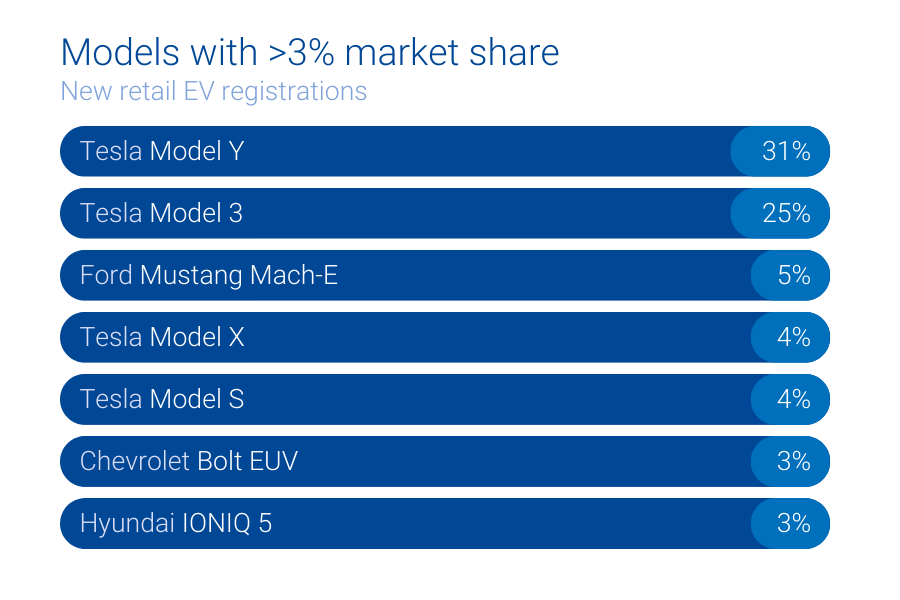
Geography
Where are we seeing the most new retail EV registrations? The top designated market areas (DMAs) for new retail EV registrations are mostly located in heavily populated, coastal cities like Los Angeles, CA and New York, NY.
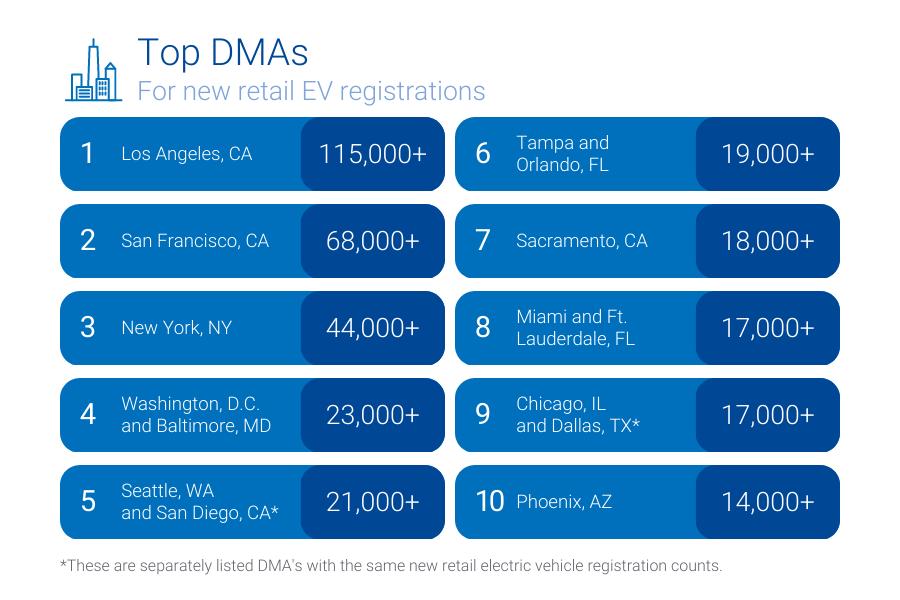
The fastest growing DMAs, however, are in smaller cities like Tucson, AZ and Oklahoma City, OK.
Generational demographics
Gen X and Millennials make up the largest percentage of new retail EV buyers at 37.5% and 34.4%. Gen Z and the Silent generation represent the smallest shares at 5% and 2.1%. Boomers hover between Gen X and Millennials’ share and account for 20.6% of new EV retail purchases.
EV audience pairings
Our top five Mosaic groups for new EV buyers include:
- American Royalty
- Cosmopolitan Achievers
- Philanthropic Sophisticates
- Couples with Clout
- Fast Track Couples
How to target consumers in-market for electric vehicles
We offer 70+ audiences that are focused on likely buyers and owners of EV and plug-in hybrid (PHEV) vehicles. We also offer a subset of 28 audiences focused on individual EV/PHEV vehicle models.
Below is how you can find a few of these audiences on-the-shelf of most trusted advertising platforms:
- Autos, Cars, and Trucks > In Market-Fuel Type > Electric
- Autos, Cars, and Trucks > In Market-Fuel Type > Used Electric
- Autos, Cars, and Trucks > In-Market Make and Models > Tesla
- Autos, Cars, and Trucks > In-Market Make and Models > Chevrolet Bolt EV
We can help you reach eco-conscious consumers
Earth Day is a great opportunity to get creative with your marketing efforts with our three eco-conscious audiences: Solar energy, GreenAware, and electric vehicles. To find out how you can add eco-conscious audiences to your marketing plan, contact us.
Get in touch
Latest posts
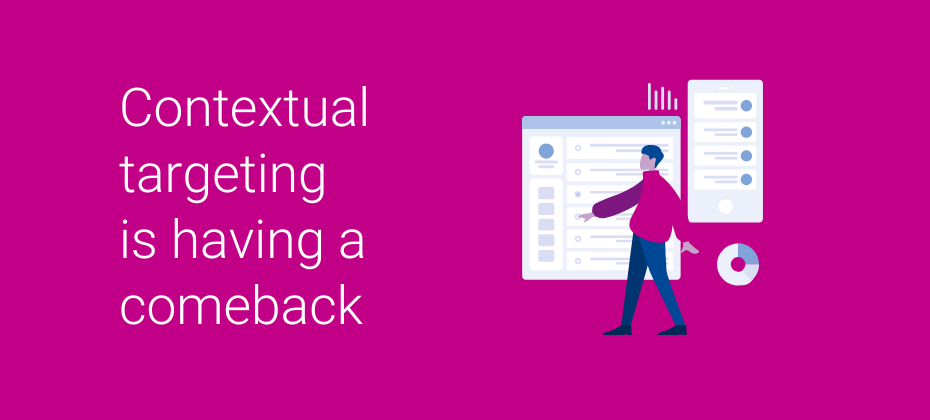
Contextual targeting is having a comeback, and it’s smarter, sharper, and more strategic than ever before. By 2030, annual contextual advertising spend is anticipated to reach $562 billion! As marketers move away from cookie-based targeting and adjust to a privacy-first digital world, contextual advertising is becoming one of the most effective ways to reach engaged audiences. Unlike the basic contextual keyword targeting of the past, today’s contextual strategies are built on data, machine learning, and deep audience insights. Experian, with Audigent, plays a key role in powering this evolution, enabling marketers to execute contextual campaigns with the precision, performance, and compliance needed for today’s environment. Let’s talk about how advertisers are reaching audiences in a changing advertising era with smarter contextual targeting. What is contextual targeting? Contextual targeting, by definition, is a cost-effective, privacy-safe way to engage audiences based on what they’re reading or watching in the moment without relying on personal identifiers. It places ads on webpages that contain content relevant to your product or service. Contextual targeting vs. behavioral targeting The concepts of contextual and behavioral targeting are commonly confused. Both aim to deliver relevant ads, but their methods differ significantly. Let’s break it down. Behavioral: Based on online behaviors Behavioral targeting builds user profiles based on factors like browsing history, clicks, and purchases, tracking users across platforms using cookies and device IDs. For example, if someone researches new SUVs on multiple sites, they might see car-related ads long after they’ve stopped actively looking. While 68% of consumers say they’re concerned about how their data is used in advertising, marketers have the opportunity to build trust through better targeting with Experian. We help brands meet rising consumer expectations with responsible, privacy-forward behavioral data and targeting options that enable you to reach audiences effectively while aligning with your privacy and control needs. Contextual: Based on content and environment Behavioral targeting will continue to play a valuable role in personalized marketing strategies, but contextual targeting is a compelling alternative or complement for strong performance in a privacy-safe, scalable, cost-conscious way. Contextual targeting focuses on the ad environment. It analyzes the page\’s content, such as keywords, tone, and structure, and serves ads that align with that context without personal identifiers or user tracking. With Experian Marketing Data, you can enhance contextual targeting further by layering in data about who’s likely to be on the page. That combination of content signals and audience intent creates smarter, more privacy-compliant campaigns that perform better. Innovations in contextual targeting In its early form, contextual targeting depended on simple keyword matches. While functional, it lacked nuance and often resulted in broad or irrelevant placements. Today, the approach is far more intelligent. Thanks to AI, machine learning, and natural language processing (NLP), platforms can now assess the full context of a webpage, analyzing tone, sentiment, structure, and content depth to determine the best ad match. Contextually-Indexed Audiences Experian’s Contextually-Indexed Audiences take contextual targeting one step further by analyzing traffic from websites and mobile applications to identify the types of frequent visitors to those pages with the power of rich consumer insights. Instead of simply showing up on relevant pages, brands can reach pre-qualified audiences mapped to those environments, combining intent, content, and data-driven strategy in a single solution. This is where contextual targeting is headed and why it\’s no longer just an alternative to behavioral but a strategic advantage in its own right. A privacy-first future Even as third-party cookies remain in use, their long-term reliability is uncertain, and the industry continues moving toward solutions that don’t depend on personal identifiers. Laws like the General Data Protection Regulation (GDPR) and California Consumer Privacy Act (CCPA) have led advertisers to rethink how they engage audiences, shifting focus from individual tracking to content and context. With modern tools, advertisers can use contextual targeting programmatic strategies to reach audiences in privacy-compliant ways that still deliver high performance. Programmatic platforms like demand-side platforms (DSPs) now offer pre-built contextual segments by industry, interest, seasonality, and more. In a few clicks, marketers can launch campaigns that align with content environments where consumers are already engaged without behavioral tracking. For brands looking to future-proof their media strategies, contextual is one of the few options that checks every box. Why more marketers are using contextual targeting Contextual targeting can help you grow your audience, drive web traffic, boost visibility, and increase conversions as data privacy regulations grow stricter worldwide. Here’s a deeper dive into the benefits of this targeting strategy. Connect with ready-to-engage audiences One of contextual targeting\’s greatest advantages is the ability to meet consumers exactly where and when they’re most receptive. It places your ads on pages where they naturally add value to the user experience. When someone is actively reading or watching content about a specific topic, they’re already in the right mindset, which makes your ad feel more like a helpful recommendation than an interruption. For example, if someone is reading a blog post comparing hiking backpacks, they’re far more likely to engage with an ad for outdoor apparel or trail shoes than one for an unrelated product like kitchenware. Drive sales and revenue while lowering costs Another draw of contextual targeting is its affordability for brands with limited budgets. It doesn’t require third-party data, identity graphs, or tracking infrastructure, so it’s easier on your media budget. By aligning ads with page context, brands can also see real business results, such as: Lower cost per thousand impressions (CPM): Since contextual ads are served based on the content of the page rather than user profiles, they often have a lower price tag — especially in verticals where access to behavioral segments may be more competitive. Reduced cost-per-acquisition (CPA): More relevant impressions mean fewer wasted clicks and better ROI. Lower cost-per-click (CPC): On networks like Google Display, CPCs for contextually targeted ads can be as low as $0.45, especially in e-commerce and consumer goods sectors. Higher conversion rates: Ads placed in relevant environments outperform generic placements, which increases the likelihood of action and conversion. Higher lifetime customer value (LTV): Users who arrive at your site from contextually aligned ads are more likely to convert and become repeat customers, driving long-term revenue. Quick and easy setup, built to perform Contextual campaigns can also be launched quickly, often within a day, and produce immediate results. One powerful option is Experian’s Contextually-Indexed Audiences, which combines real-time analysis from over two million websites with access to more than 1,400 trusted audience segments. Available through top demand-side platforms’ contextual marketplaces and Audigent private marketplaces (PMPs), this solution offers a scalable way to reach high-intent consumers without cookies or IDs. Getting started is simple. With a few inputs like relevant topics, keywords, or content categories, you can activate ads in environments where your audience is already engaged. And the best part? The ease and speed to launch doesn’t mean you’re sacrificing results. Because your ads show up alongside content your audience is already interested in, they feel timely and relevant, which leads to more clicks, stronger engagement, and better overall performance. Personalized experience based on known interest Consumers crave personalization. In fact, Deloitte conducted a 2024 study that found 80% of consumers want personalized brand experiences and spend 50% more with the ones that do. Contextual targeting meets that expectation by delivering relevance in the moment without tracking users’ online behavior.Experian’s Contextually-Indexed Audiences use contextual cues across the web to find common sets of audiences and identify where high-intent audience segments tend to show up. This helps advertisers deliver relevant, privacy-safe messaging to consumers who are more likely to engage, thereby building trust, capturing attention, and increasing performance while respecting user privacy. Brand safety Contextual targeting even helps brands avoid reputational pitfalls. With the help of AI and NLP, today’s contextual tools can assess what a page says and how it says it. That means you’re not just protecting user privacy but also your brand by ensuring your ads appear in relevant, trustworthy environments that reflect your values. Contextual targeting examples Contextual targeting works across nearly every industry, helping brands connect with audiences based on the content they’re consuming in the moment. Here are a few examples of this in action across verticals. Contextual targeting for automotive buyers Most car buyers don’t just walk onto the lot. They arrive informed, having begun their journey online, researching makes, models, financing options, trade-in values, and credit requirements. It’s during this discovery phase that contextual targeting shines. Advertisers in the automotive space can serve ads alongside car reviews, dealership comparisons, or articles about electric vehicle tax credits, connecting with shoppers actively gathering information and signaling strong purchase intent. When your ad appears in the middle of that research journey, it feels like the next logical step. Contextual targeting also helps local dealerships and national brands stay top of mind during key decision-making moments without relying on third-party cookies. Contextual targeting for first-time parents New parents are one of the most information-hungry audiences online. From sleep training and stroller reviews to feeding schedules and baby-proofing tips, they consume a massive amount of content across various topics. That content provides a rich canvas for contextual targeting. Brands selling baby gear, wellness products, insurance plans, or parenting services can place ads on relevant articles and forums, connecting with parents when they’re researching their options and making purchase decisions. Contextual targeting for political campaigns Contextual targeting helps political advertisers connect with voters in relevant, mission-aligned environments. In a time when misinformation and divisiveness can influence public perception, maintaining this control is more critical than ever. With contextual targeting, campaigns can place their ads alongside trustworthy, high-quality content that addresses issues relevant to their supporters, whether it’s local policy, national news, or editorial commentary aligned with their platform. Advertisers can also avoid content that may contradict their message or brand values. The future of contextual targeting While Google no longer plans to fully deprecate third-party cookies, the industry has already moved forward. Most marketers have invested in cookieless solutions, and that momentum isn’t slowing down. As contextual targeting becomes even more essential to future-proofing media strategies, its effectiveness depends on the quality and responsibility of the data behind it. That’s where Experian leads the way. Experian Marketing Data as the foundation At the core of Experian’s contextual targeting capabilities is Experian Marketing Data: a rich, privacy-compliant data set built from verified offline sources. This foundational data powers everything we do and fuels the full suite of Experian’s audience and targeting solutions. Marketing Attributes and Audiences One of the key products built from this data is Marketing Attributes, which transforms raw information into detailed, privacy-safe variables like lifestyle preferences, financial behaviors, and media habits. These attributes form the building blocks of Experian Audience solutions, allowing you to create highly specific segments tailored to your goals. When applied to contextual targeting, these segments help you align your messaging with the types of content your ideal audiences are consuming in real time. We’ll help you activate contextually relevant campaigns using real audience insight to place the right message in the proper environment at the ideal moment. Contextually-Indexed Audiences Powered by Experian Marketing Data, Contextually-Indexed Audiences brings a new level of precision to contextual targeting. By analyzing traffic from over two million websites and apps, we offer access to 1,400 audience segments (like luxury shoppers or frequent travelers) that are most likely to visit specific content. This lets you place your message in environments where your target customers already are, combining contextual relevance with data-driven intent. It’s a smarter, privacy-safe way to reach the right people without relying on cookies or user tracking. You can activate these audiences instantly through the top demand-side platform’s contextual marketplace or partner with Audigent to create a custom PMP. A PMP offers more control and flexibility and allows you to enhance campaign performance with additional performance optimization capabilities and activation across any media-buying platforms. Experian collaboration with Audigent and Peer39 Experian and Audigent partner to deliver SmartPMPs, or private marketplace deals that give advertisers access to premium inventory and privacy-first data activation in one streamlined solution. What makes this partnership unique is Audigent’s supply-side integration. Instead of only running audience segments through the DSP, SmartPMPs pair Experian’s high-performing audiences with curated inventory from thousands of publishers, all accessible through a single deal ID. This supply-side approach unlocks: Better reach across CTV, display, video, and more Stronger performance through real-time supply optimizations Personalized campaigns that don’t rely on cookies or user-level identifiers We’ve also partnered with Peer39 and Audigent to expand contextual targeting capabilities further. These partnerships make it possible to match Experian syndicated audience segments, including geo-indexed and behavioral data, to contextual signals in real time. Advertisers can now run fully cookieless campaigns with exceptional scale and performance by indexing Experian Marketing Data through our identity graph and activating through platforms like Audigent’s Hadron ID or Peer39’s integrations. In one beta test with Audigent, a major national advertiser used this solution to run a 15-day campaign that exceeded CTR benchmarks by 25% with no cookies or IDs. Talk to an Experian team member today The future of digital advertising is about trust as much as performance. Turn to Experian for help reaching your audience in the right environments using ethically sourced, privacy-first data. We help brands run scalable, contextually aligned campaigns built for today’s privacy landscape and tomorrow’s performance goals. With tools like Marketing Attributes, Contextually-Indexed Audiences, and Audigent PMPs, we make it possible to connect meaningfully without crossing privacy boundaries. Let’s talk about how we can help you lead the way. Latest posts
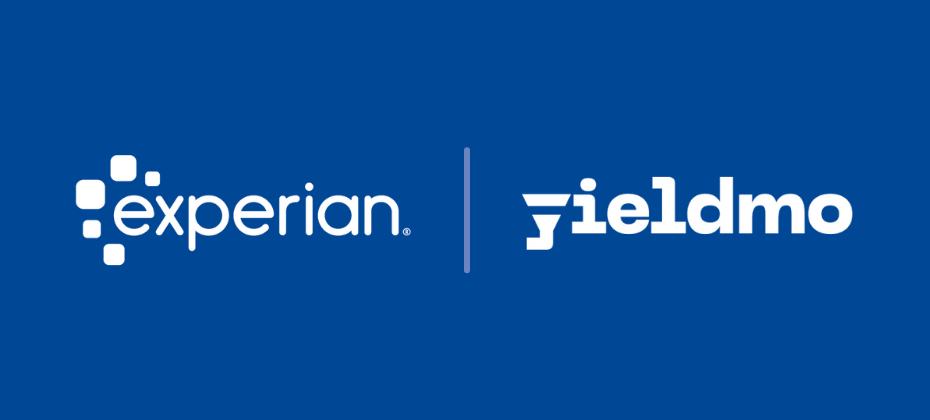
Supply-side platforms (SSPs) are expected to deliver more than inventory—they’re being asked to support sell-side targeting strategies, campaign results, and proof of performance. To meet that demand, SSPs need more than access to inventory. They need better data, better tools, and a way to bring it all together. Experian’s solutions for SSPs We built Experian’s solutions for SSPs with that demand in mind. By combining identity resolution, audience targeting, and third-party measurement, we help platforms move beyond basic transactions. Whether you’re doing sell-side targeting, supporting direct deals, or looking to support campaign validation, our tools make it easier to create value for buyers—and keep them coming back. Our solutions that help SSPs: Resolve identity across digital touchpoints using our industry-leading Digital Graph Build differentiated audiences using over 2,400 Experian Audiences and Partner Audiences in Audience Engine Support advertiser-direct relationships with tools to create, activate, and host custom segments Measure real outcomes like in-store visitation and sales through Outcomes, our third-party validated reporting suite Together, these capabilities allow SSPs to produce data-driven deals, increase addressability, and meet buyer demand for smarter, more measurable media. Campaign snapshot: Yieldmo + Experian Yieldmo, an advertising platform known for its creative formats and data-informed approach, has already put this solution to work. Here’s how they built a custom strategy for a major athletic retail client using Experian\’s joint solution for SSPs. The challenge: Drive in-store traffic and reach new buyers Yieldmo supports a leading athletic retailer’s seasonal campaigns focused on in-store traffic. This advertiser wanted to reach new buyers—specifically those who might otherwise shop with a competitor. To do this, they needed access to strong audience segments with reliable data and the flexibility to act quickly across channels. This was the first time Yieldmo applied Experian Audiences to this retailer’s campaigns. The stakes were high: the client was looking for better in-store outcomes and a more streamlined activation workflow. The solution: Experian\’s activation solution for SSPs Using Experian’s Audience Engine, which includes our proprietary and third-party data marketplace, Yieldmo built a flexible, high-performing media plan that spanned display inventory and included both conquesting and primary in-store shopper segments. The team selected and activated: Apparel and footwear audiences built from Experian and partner data providers In-store shopper segments targeting retail behavior signals Competitive purchasers to capture likely buyers from other athletic brands Our data marketplace allowed Yieldmo to combine Experian Audiences with Partner Audiences from providers like Alliant, Circana, Sports Innovation Lab, and Webbula—all in one place. Manual audience creation used to take days. Now, Yieldmo can build and activate campaigns through a streamlined, self-serve workflow. By working in the Audience Engine platform, Yieldmo was able to avoid multiple contracts and manual requests. They filtered audiences by brand, tailored segments to their goals, and launched without delays. “Experian’s data marketplace in Audience Engine fills a critical gap—letting us quickly search by brand, build smarter conquest segments, and activate custom audiences fast.”Abby Littlejohn, Director of Sales Planning, Yieldmo The results: Expected lift in store visits While final in-store lift results are pending, the early performance metrics are promising: Click-through rates are at and above historical benchmarks across both conquesting and primary shopper segments. Using Audience Engine’s self-serve tools, Yieldmo created audiences faster and more easily. They reduced their workload by minimizing the need for manual data wrangling. “We include Experian audience segments in 80% of formal RFPs. Between contract simplicity, data quality, and campaign results, Experian has become our go-to for third-party audience targeting.”Nelson Montouchet, AVP, Strategic Partnerships, Yieldmo Download the full case study Bring this to your platform Whether you’re looking to monetize more effectively, build deeper advertiser relationships, or stand out with sell-side targeting offerings, we designed Experian’s solutions for SSPs to do exactly that. With our industry-leading Digital Graph, over 2,400 syndicated audiences, partner data, flexible self-serve tools, and outcome-based measurement, SSPs can now move faster and go further—without compromising scale or precision. Get in touch with our team Latest posts

After another week under the sun at Cannes Lions 2025, one thing is abundantly clear: our industry is done talking about possibilities — it’s ready to act. From speaking engagements to packed suite meetings, and even stateside through our “Can’t Cannes” activations, the appetite for change was real — and we were right at the center of it. A front-row seat to innovation Experian made a powerful impact across the Croisette, partnering with Audiostack, Basis, Infillion, IQVIA, Magnite, NextRoll, Odeeo, OpenX, The Female Quotient, and the Unplugged Collective x The Digital Marketer, to contribute to some of the week’s most insightful conversations. Our thought leaders were everywhere—on stage, in studio interviews, at executive roundtables—offering a clear voice on retail media growth, pharma advertising disruption, AI innovation, and identity-driven personalization. Three themes that defined the week 1. AI gets real If 2024 was the year of AI buzz, then 2025 is the year AI found its footing. Conversations shifted from “what if” to “what now.” While the promise of AI was front and center, conversations with clients and partners highlighted that we’re still in the foundational phase. Real-world applications—from creative optimization to predictive segmentation—are gaining traction, but long-term value will depend on robust data architecture and trustworthy identity frameworks. MiQ and PMG debuted AI-integrated platforms that demonstrated how AI can automate creative, optimize budget allocation, and personalize media in real time. AI has moved from sidekick to strategist. \”Last year it was all about AI, but in a very general sense. This year, it’s about specific applications — a clear sign AI is evolving from a talking point into product.”Budi Tanzi, VP, Product 2. Outcomes > impressions Outcomes may have been a buzzword at Cannes, but as several industry leaders pointed out, simply saying “we drive outcomes” isn’t enough—it risks sounding like table stakes. In today’s performance-driven environment, what matters is how companies define and deliver those outcomes in unique ways. The most compelling conversations weren’t about generic promises, but about clear strategies: challenging assumptions, leaning into strengths, and making specific choices that tie data, media, and technology to measurable impact. \”By using consistent identity across planning, activation, and measurement, marketers can connect ad exposure to real-world outcomes—whether that’s an online conversion, an in-store visit, or a new customer relationship.\”Chris Feo, Chief Business Officer 3. Curation isn\’t just a tactic Curation is quickly becoming the industry’s preferred approach to cutting through complexity. As marketers contend with signal loss and inconsistent inventory quality, the shift from broad access to intentional activation is gaining momentum. At Experian, we see curation not just as packaging, but as strategic alignment—where identity, data, and inventory come together in purpose-built environments that reduce waste, enhance safety, and drive performance. \”Supply-side data activation and optimization, aka “curation,” is an alternative to the traditional approach to data activation. Unlike the traditional DMP-to-DSP activation flow, curation allows buyers to leverage supply-path data more directly. The upshot? Improved performance and pricing for media agencies and brand advertisers.\”Drew Stein, Managing Director, Audigent Bringing the Cannes experience stateside Not everyone can make it to the South of France—so we brought Cannes to them. Our “Can’t Cannes” events in the U.S. offered local clients a first-class experience filled with insights and networking, minus the jet lag. Final takeaways This year’s festival made one thing clear: real progress requires more than innovation; it requires integration. And that’s where Experian is focused—connecting identity to activation, and data to outcomes, in ways that are practical, scalable, and privacy-resilient. If I had to sum it up? AI is progressing from abstract to application Curation beats clutter Partnership is power And everyone’s aligned around performance We’re grateful to have been part of these conversations and even more excited about where they’ll lead next. Let’s continue the conversation If you\’re exploring how to connect identity to performance, or simplify the way you activate, measure, and grow, we’d love to talk. Latest posts